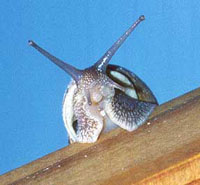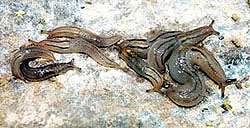|
Gastropoda:
snails and slugs

Helix aspersa (common garden snail) |
|

|
|
|
Characteristics
Slugs
and snails belong to a larger group (or Phylum) known as the Mollusca.
Molluscs come in many different forms but are predominantly categorised
as soft-bodied animals without body segmentation that often have
an external shell made of calcareous
material.
Snails and slugs
are known as gastropods, which mean 'stomach foot'. This describes
the way in which the body and internal organs of slugs and snails
has been twisted back so that the stomach lies above the large fleshy
foot of these animals. The head is at one end of this foot the snail
or slug moves by gliding along a surface of mucus or slime that
is produced from glands on the foot. All gastropods have a well-developed
head with eyes and 1-2 pairs of tentacles.
Life Cycle
Most gastropods
are hermaphrodites,
which means that each animal has both male and female reproductive
organs in the same body. When two individuals snails or slugs meet
they exchange bundles of sperm, usually via a dart into the tissue
of the other. Eggs are then usually laid in crevices in the soil
or under rocks, while some species may give birth to live young.
Feeding
Most gastropods
are herbivores
and scavengers
feeding on fungi, dead animal material and plant matter such as
leaves, stems, bulbs and algae. A few are carnivorous
and may prey on other snails. All gastropods feed by using a radula,
which is a tongue-like structure covered by rows of rasping teeth.
|

Helix aspersa (common garden snail)
|
Habitat
Gastropods
are found in a variety of habitats across Australia but favour moist
environments. Most native species can be found hiding under logs
and rocks, in leaf litter or under the bark of trees. During humid
weather or times of rainfall they can be seen foraging for food
or looking for mates. Slugs are particularly susceptible to drying
out and some snails may wait out a dry period by sealing themselves
to a hard surface with dried mucus and staying inactive, this is
sometimes known as aestivation.
In some agricultural areas of South Australia aestivation by introduced
snail species causes problems as huge numbers congregate in crops
to aestivate
over the hotter months contaminating the harvest.
|




